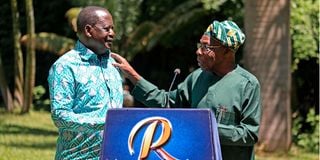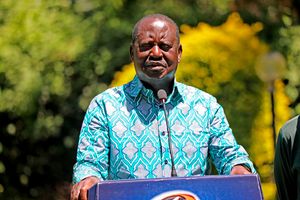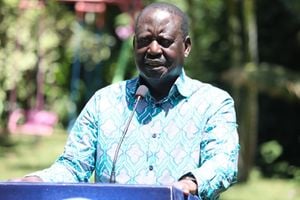
Azimio la Umoja leader Raila Odinga (left) with former Nigerian President Olusegun Obasanjo in Nairobi on February 15, 2024.
It will be a win-win situation if opposition leader Raila Odinga gets President William Ruto’s active backing and goes on to win the top African Union job.
The President will reap dividends in the absence of a gadfly who has tormented successive governments with perpetual agitation.
The veteran opposition chief will have earned the perfect soft landing in retiring from Kenyan politics to a seat that should satisfy his ardent supporters as a major accomplishment in its own right, and maybe to some even bigger than the Kenyan presidency.
Though Mr Odinga, in an interview with The Weekly Review (see verbatim excerpts) dismisses as groundless speculation reports that he has cut a deal to go easy on President Ruto in exchange for the AU assignment, it is obvious that he can hardly keep on applying pressure when it is vital that he get full official support in lobbying other African countries to vote for him.
He also remains coy on whether seeking chairmanship of the African Union Commission signals imminent retirement from local politics, and specifically abandoning plans for a sixth stab at the presidency come the 2027 elections.
Mr Odinga says that even if he wins the AU poll and relocates to the continental body headquarters in Addis Ababa, Ethiopia, there is nothing to prevent him from answering the call of his supporters and coming back home to run for president again come the time.
That would be highly improbable, and such a narrative would complicate the lobbying efforts required to line up other African governments behind his candidacy.
Running the AU Secretariat is a full-time job, not some vacational appointment to be abandoned any time something more attractive comes along.
What is clear now is that Mr Odinga seems set on getting official Kenyan backing evidenced by statements from Prime Cabinet Secretary and Cabinet Secretary Foreign Affairs Musalia Mudavadi on the sidelines of the AU ministerial meeting in Addis.
It was Mr Mudavadi — a key ally of Mr Odinga before ditching him for President Ruto ahead of the 2022 elections to decisively swing momentum to the Kenya Kwanza alliance — who let the cat out of the bag at a public meeting in the Siaya County backyard of the opposition chief at the end of January.
Without mentioning Mr Odinga by name or going into specifics, he referred cryptically to good news in the offing. That news has now come to light, and it is unlikely that Mr Mudavadi would have revealed something unless aware that the President was aware of it and had given a seal of approval.
Even if there has been no direct contract with President Ruto as Mr Odinga insists, it is obvious that there must have been some backchannel communication through intermediaries.
In that regard, the involvement of former Nigeria President Olusegun Obasanjo is very telling.
The veteran African statesman was by his side and gave his unqualified endorsement when Mr Odinga called a press briefing last Thursday at his Kerarapon residence in the Karen suburb to confirm that he was going for the AU job.
That was after newspapers broke the story, meaning Obasanjo was already in the country. From Karen, the former Nigerian President was driven to a local political event in Murang’a where he met President Ruto, who no doubt was aware of his mission in the country.
In March last year, it was Obasanjo who brokered a truce that saw Mr Odinga call off a series of bloody demonstrations in exchange for President Ruto agreeing to dialogue on issues such as the cost of living, electoral justice and more inclusive government.
The President and the opposition chief subsequently appointed a National Dialogue Committee, whose report now awaits debate and ratification by Parliament.
It was initially reported that it was President Ruto who had reached out to Mr Odinga for a peace deal, but it later transpired that it was Mr Odinga who made the first approaches through Obasanjo.
Whatever the case, a halt to the street protests offered welcome respite for both President Ruto and Mr Odinga. The latter could get on with trying to put his agenda on track without distractions, while the former was spared flogging efforts to keep the agitation going.
Unlike the post-2017 elections ‘handshake’ between Mr Odinga and then President Uhuru Kenyatta, the dialogue with President Ruto did not amount to a political partnership. Neither does the President’s support for Mr Odinga’s AU bid, which it best would be a convergence of interests.
Still, it has great political ramifications. Mr Odinga has most of his adult life stood out as the motive force behind opposition politics on Kenya.
He was at the forefront during the struggle for a multi-party system in 1990, and since then whether in out of government has driven the cause for reform and change.
In the arena of Luo politics and the ODM party, he bestrode the landscape like a colossus, with no viable successor presently in sight.
The only figures presently with clear national profiles, such as Peter Anyang’ Nyong’o and James Orengo, governors respectively for Kisumu and Siaya counties, have been in the trenches with Raila from even before the multi-party campaign. They are also in their 70s.
Mr Odinga also stands head and shoulders above all his partners in the opposition Azimio coalition, a fragile movement with party leaders all trying to find their space in the post-Raila era.
Wiper Party leader Kalonzo Musyoka has been insisting, as he always does ahead of every election, that he will not stand down for Raila again and will be in the presidential ballot come 2027.
The former Vice President amassed an impressive Kamba vote of 1 million plus for Mr Odinga at the last three elections, but is yet to prove his pull beyond the community. He also does not come as across as an inspiring leader grounded in clear policies and ideology.
Mr Odinga’s 2022 running mate, Narc-Kenya leader Martha Karua, was seen as an inspiring choice, but when push came to shove, was unable to garner any worthwhile vote for the ticket in her populous Mt Kenya region.
It is evident that all of Mr Odinga’s constituencies might be left leaderless and in a state of flux if he exists the scene before crafting a clear succession plan. Then there is the reality that even with President Ruto’s support, the AU job is not a done deal.
Assuming that the informal pact is adhered to and the rest of the continent leaves the post for eastern Africa, there is no telling at the moment if President Yoweri Museveni of Uganda, Paul Kagame of Rwanda or other leaders in the wider region might move to front their own candidates.
It is instructive that Kenya’s former Foreign Affairs Cabinet Secretary Amina Mohammed was highly tipped to land the job on presumption that it was East Africa’s turn in 2017, only to lose out to Moussa Mahamat Faki of Chad when the region failed to rally behind her.
Mr Odinga the will need all of Kenya’s diplomatic muscle to lobby first, other countries in the eastern region before fanning out to south, central, west and north.
There is no doubt that Mr Odinga’s long experience as an African nationalist has earned him powerful friends and allies across the continent, but lobbying for such jobs by necessity involves government rather than personal contacts.
For now, he might be considered the front-runner, but in the absence of any other declared candidate.










